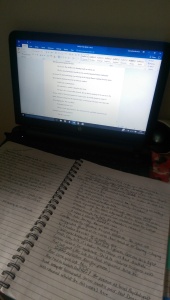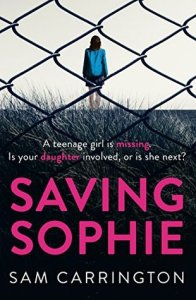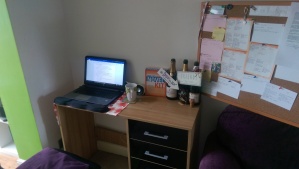I’m really pleased to welcome Sam Carrington to the blog today to talk about her first draft process.
 Sam lives in Devon with her husband and three children. She worked for the NHS for fifteen years, during which time she qualified as a nurse. Following the completion of a psychology degree she worked for the prison service as an Offending Behaviour Programme Facilitator. Her experiences within this field inspired her writing. She left the service to spend time with her family and to follow her dream of being a novelist. SAVING SOPHIE is her debut psychological thriller novel.
Sam lives in Devon with her husband and three children. She worked for the NHS for fifteen years, during which time she qualified as a nurse. Following the completion of a psychology degree she worked for the prison service as an Offending Behaviour Programme Facilitator. Her experiences within this field inspired her writing. She left the service to spend time with her family and to follow her dream of being a novelist. SAVING SOPHIE is her debut psychological thriller novel.
When you decide to write something new, what is the first thing you do?
I write a paragraph or so of the opening scene. This will have been playing around in my head for a few days and will include the initial activating event, along with the bare bones of the characters who are captured in that first scene. From this I will begin building a picture of who those characters are, what their backstory is, and what other characters I will need to interact with them.
Do you have a set routine approaching it?
Yes. I have a corkboard and pads of paper to set out the characters: their physical attributes, their history, their goals – and I pin one for each character on the board. I continue this for each main character, and then for the minor ones.
 Pen and paper or straight to the keyboard?
Pen and paper or straight to the keyboard?
For the opening scene and possibly the first chapter I will go straight to the keyboard. Then I will revert to pen and paper to make lots of notes. I might also hand write the odd scene or two – but once the story starts properly, I type straight into the word document.
How important is research to you?
It depends on what I’m writing about! It’s important to me if it’s something that I’m going to draw heavily on. In that case, I might research something before writing, as I did for the character of Karen in SAVING SOPHIE as she suffers from anxiety and agoraphobia. Other times I will write what I think is right, then research it later and amend where necessary. I think it depends on what it is, and whether I feel I have enough knowledge personally, or professionally. When it comes to setting, I have written about places I know well, or live close to, so if I need to know something about it I can just pay a visit. I don’t want to get bogged down with research, or worry unduly about getting everything right – it IS fiction, after all. However, I do know that readers like accuracy and so I will do my best to be mostly accurate. But if I need to embellish something, or twist it slightly to fit my story, well – I will! Writer’s prerogative?
How do you go about researching?
Good old Google is my first port of call! Or friends and relatives who might have knowledge of my subject area. I’m also lucky to have worked in the prison service and spent a lot of time with offenders. So from that side of things, I feel confident in some details pertaining to the criminal mind…
How do you store everything; ideas, research, images that catch your eye?
As I mentioned, my corkboard is my main aid. I use my faithful ‘Writer’s Toolbox’ which includes various pads and I have dozens of notebooks to jot down ideas and research. Any images also get stuck to the board.
Tell us how that first draft takes shape?
Slowly! So far, for the two novels I’ve written (one being an ‘in the drawer’ one) and my current work-in-progress, I have written in a fairly linear way – starting at the beginning and writing in the order it will be read. I am an edit-as-you-go writer, so I have to be happy with a chapter before moving on.
Are there any rituals you have to do or items you must have with you while writing that draft?
I need to have a few cups of coffee before I get stuck in with writing. I might also have to squirrel away some snacks which will be required when I’m in the zone!
Does the outside world exist or are you lost to us for a period of time as the magic works?
Oh, God – SO lost! When I’m really engrossed in a scene, nothing gets in the way. Time also has a habit of speeding up and I’ve been known to forget to pick up my children from school/college. They love me. It’s all good.
What does your workspace look like?
Currently it’s a bit cramped! I’ve got my youngest son’s cast-off desk and there’s just too much on it. Plus, it’s situated in the lounge/diner so there’s not a lot of space all round! I really. REALLY want my own hideaway…
Edit as you go or just keep getting words out?
Edit as I go. I can’t help myself. I do manage to leave certain paragraphs and move on if I can’t get them right, or I need to check facts – in which case I highlight so that I can go back to it.
I see many writers counting words in a day. Word counter or other method of keeping track of progression?
I do attempt to keep to a daily word count. I keep track by writing down the words I’ve written, and how many words left to my target, in a notebook. I either find it incredibly motivating – or incredibly scary!*
*Currently it’s in the ‘incredibly scary’ category!
So, that first draft is down. Roughly how long did it take? And what shape is it in?
Because I edit as I go, the first draft is generally in quite good shape (I think!) SAVING SOPHIE took approximately 7 months. My current work in progress is taking longer!
In what format do you like to read it through, ereader, paper or the computer screen?
Computer screen. I have never printed my manuscript out.
What happens now that first draft is done?
I open the bubbly!!!
Then I will give it a week or so before reading through and doing the first round of edits (with the aid of more bubbly!)
Thanks for digging into the depths of the first draft. It’s been a pleasure having you.
You can find Sam on Amazon | Blog | Twitter
Saving Sophie
 A teenage girl is missing. Is your daughter involved, or is she next?
A teenage girl is missing. Is your daughter involved, or is she next?
Your daughter is in danger. But can you trust her?
When Karen Finch’s seventeen-year-old daughter Sophie arrives home after a night out, drunk and accompanied by police officers, no one is smiling the morning after. But Sophie remembers nothing about how she got into such a state.
Twelve hours later, Sophie’s friend Amy has still not returned home. Then the body of a young woman is found.
Karen is sure that Sophie knows more than she is letting on. But Karen has her own demons to fight. She struggles to go beyond her own door without a panic attack.
As she becomes convinced that Sophie is not only involved but also in danger, Karen must confront her own anxieties to stop whoever killed one young girl moving on to another – Sophie.


What an interesting background! And I can see how it informs your writing. And I agree about waiting for a time after a story is done to read it and start on the edits; I think that’s the best way to go about it – your mind is fresh then. Wishing you much success! Thanks, Rebecca, for this great feature!
LikeLiked by 1 person
Thanks very much, Margot!
LikeLiked by 2 people
Open the bubbly – you bet!
Some days the word count is incredibly scary.
LikeLiked by 2 people
It really can be! I have a few scary word count goals coming up for book 2 (deadline is looming). I’m very much looking forward to the bubbly stage!
LikeLiked by 1 person